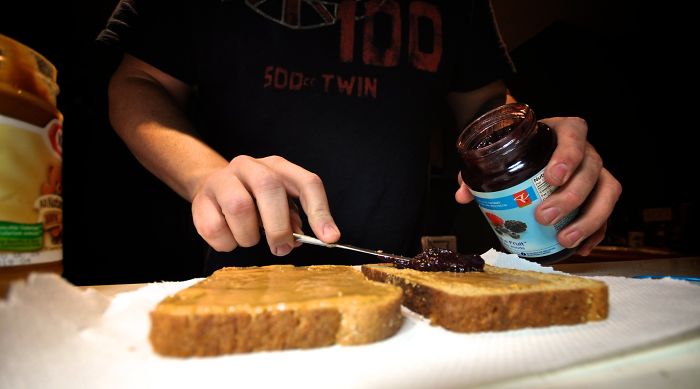Betty White is a legend in her own right. This sweetest little lady has not only won the hearts of virtually everyone for her uplifting personality, she has also earned a Guinness World Record for the longest TV career for a female entertainer.
The comic dynamo has been performing for more than 74 years in the entertainment industry, and it makes us wonder how come she is not a superhero!
Well, Betty was born on January 17, 1922, which makes her only two years away from celebrating her hundredth birthday. It means this almost centenarian actress is older than sliced bread, and color television, and… well, the list of important inventions is down below. And it really puts Betty’s legend into a historical perspective!

Image credits: Angela George
This post may include affiliate links.
Penicillin
Penicillin was discovered in 1928 by professor Alexander Fleming.
Sliced Bread Was Intented In 1928
Sliced bread was invented in 1928. Otto Frederick Rohwedder created the Chillicothe Baking Company, which sold the first loaf that utilized Rohwedder's bread-slicing machine.
Color Television
June 25, 1951 was the day when CBS broadcast its first color TV show. Unfortunately, no one could tell because they all had black-and-white TV sets. The first program in color was called "Premiere."
Betty White, who has spanned more than 80 years in the entertainment industry, is regarded as one of the television pioneers. The famous actress is also known as the first woman to produce a sitcom, “Life With Elizabeth,” which led her to receive the honorary title Mayor Of Hollywood in 1955.
In 1939, just after graduating high school, Betty began her radio career, soon switching to television. Her career skyrocketed. But with WWII, she shelved her ambitions and joined the American Women's Voluntary Services. Of that era, she told Cleveland Magazine, "It was a strange time and out of balance with everything."
Scotch Tape
1929 was the year when this life-saving tape was invented.
But tape was invented in 1845....but it wasn't SCOTCH tape.
Canned Beer
Although we've had canned beverages since 1813, mass production of them only started in 1935.
The Electric Traffic Signal Was Created In 1923
After witnessing an accident between an automobile and a horse-drawn carriage, African American inventor, Garrett Morgan, filed a U.S. patent for a traffic signal. Patent] was granted on 20 November 1923 for Morgan's three-position traffic signal.
The world's first traffic light was a manually operated gas-lit signal installed in London in December 1868. I’m not sure she’s quite that old yet. The first automated traffic control system dates back to 1910.
Betty was a regular on the game show circuit when she met her match in 1961, hosted by Allen Ludden. He became Betty’s third and last husband, and their stars on the Hollywood Walk Of Fame sit side by side to this day.
In Betty’s more than eight decades in the business, her trademark smile, gracious demeanor, and clever wit have made her a living legend.
Frozen Food
Before 1929, frozen food was not a thing.
Bubble Gum
In 1928, Walter E. Diemer, an accountant for the Fleer Chewing Gum Company in Philadelphia, was experimenting with new gum recipes. These experiments turned out to be successful.
The Slinky
In 1943, the mechanical engineer Richard James accidentally came up with the toy when he was trying to find a way of keeping products on ships undamaged.
Nuclear Fission
The discovery of nuclear fission occurred in December 1938 by Lise Meitner, Otto Frisch, and Otto Hahn. Meitner and Frisch were physicists and Hahn was a nuclear chemist.
1957: Birth Control Pill
Enovid, a drug the FDA approved for menstrual disorders, came with a warning: The mixture of synthetic progesterone and estrogen also prevents ovulation. Two years later, more than half a million American women were taking Enovid—and not all of them had cramps. In 1960, the FDA approved Enovid for use as the first oral contraceptive.
Automatic Wrist Watches
Automatic wrist watches became a thing back in 1923.
Automatic (self winding) wrist watches in 1923. Automatic pocket watches were invented over 100 years earlier.
Trampoline
The first modern trampoline was built by George Nissen and Larry Griswold in 1936. Nissen was a gymnastics and diving competitor and Griswold was a tumbler on the gymnastics team.
LSD
LSD was first synthesized on November 16, 1938, by Dr. Albert Hoffman.
Jukeboxes
In 1927, Betty White was already five years old when the first jukebox that automatically shifted records was introduced to the public.
Automatic disc changing music boxes became a thing in 1899, so this is more of a stretch.
Barbie
In 1959, the world was introduced to Barbie.
Who was an American remake of "Lilli", a fashion doll launched on 12 August 1955, created by Rolf Hausser in the likeness of the main character of a single-panel cartoon by Reinhard Beuthien for the German "Bild" newspaper, first appearing on 24 June 1952. While there were definitely knock-offs by rival toy companies, Ruth Handler -- who may or may not have wanted to create such a doll to replace paper dolls -- bought one while on holiday in Switzerland in 1956, "adapted" the design with the help of Jack Ryan, and launched "Barbie" on 9 March 1959. Post-WW2 anti-German prejudice may have been involved, but when Mattel bought the copyright in 1964 (after being sued for copyright infringement in 1961 by Louis Marx and Company, who had the legal license for the doll) the newspaper could no longer print the cartoon nor the toy company the doll.
Bean Bag Chair
1969 was the year of Woodstock and when beanbag chairs became a thing.
The Ballpoint Pen Was Invented In 1924
Unfortunately not. The first mass produced ballpoint pen was patented in 1924. In 1938 an upgraded one was invented/patented.
Notebooks With Spiral Bindings Were Invented In 1924
M&m’s Candy Invented 1941
I used to think that different colors were different flavors for some reason
Big Mac
The Big Mac wasn't introduced until 1967. McDonald's was originally a hot dog stand that only turned to burger-making in 1948.
Electric Razor
Up until 1931, non-electric razors were not only a choice, but also the only possibility.
The Rubik's Cube – Invented 1974
Instant Coffee
Coffee may have existed for centuries, but instant coffee has been here with us since 1938.
1982: Computer Virus
Fifteen-year-old Rich Skrenta created an application called Elk Cloner as a prank—and ended up creating the first virus to spread outside its home network. Elk Cloner spreads via floppy disk and attaches to the Apple OS II operating system. When users boot from the disk, Elk Cloner transfers the computer's memory; any additional disks inserted without rebooting are also infected. On every fiftieth boot, the computer displays text written by Skrenta:
Elk Cloner: The program with a personality / It will get on all your disks / It will infiltrate your chips / Yes it's Cloner! / It will stick to you like glue / It will modify ram too / Send in the Cloner!
The Internet
In the 1950s, first computers were created. By 1965, MIT released the first wide area network (WAN). Four years later, the first successful internet message was sent from UCLA to Stanford Research Institute. But it took a while for memes to become a thing.
Microwave Oven
In 1945, the heating effect of a high-power microwave beam was accidentally discovered by Percy Spencer. In 1947, Raytheon built the "Radarange," the first commercially available microwave oven.
He realized it could be used for cooking when he turned it on and the chocolate bar he had in his pocket melted.
1956: Hard Drive
IBM released the first computer hard disk drive, the 2,000-pound-plus, refrigerator-sized IBM 305 RAMAC, which introduced magnetic disk storage. Up until then, files were either kept on spools of magnetic tape or on good old-fashioned paper, with no way to jump right to the record you wanted to pull up. With the RAMAC, a mechanical arm would retrieve data by storing data at a particular magnetic orientation. This technology went on to be used (at a smaller size) in laptops and computer servers everywhere.
Forget hard drives, what is essentially the first electronic, digital, programmable computer (i.e. what we think of as a computer today), ENIAC, was only completed in 1945.
Garages
C.G. Johnson invented the electric garage door opener in 1926.
Garbage Disposal
The garbage disposal unit was invented in 1927 by John W. Hammes, an architect working in Racine, Wisconsin. He applied for a patent in 1933 that was issued in 1935.

 Dark Mode
Dark Mode 

 No fees, cancel anytime
No fees, cancel anytime 




















































































